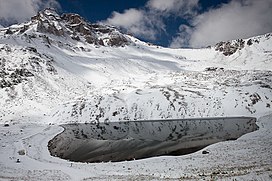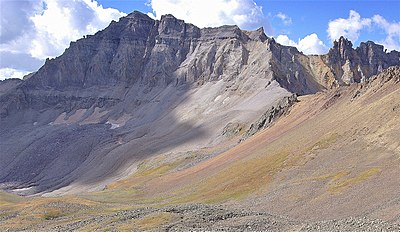| Gilpin Peak | |
|---|---|
 Gilpin Peak and Wright Lake | |
| Highest point | |
| Elevation | 13,700 ft (4,176 m) [1] [2] |
| Prominence | 720 ft (219 m) [2] |
| Parent peak | Mount Sneffels [2] |
| Isolation | 1.20 mi (1.93 km) [2] |
| Coordinates | 37°59′12″N 107°47′35″W / 37.9866601°N 107.7931174°W [3] |
| Naming | |
| Etymology | William Gilpin |
| Geography | |
| Location | Ouray and San Miguel counties, Colorado, United States [3] |
| Parent range |
San Juan Mountains, Sneffels Range [2] |
| Topo map |
USGS 7.5' topographic map Grays Peak, Colorado [3] |
Gilpin Peak is a high mountain summit in the Sneffels Range of the Rocky Mountains of North America. The 13,700-foot (4,176 m) thirteener is located in the Mount Sneffels Wilderness of Uncompahgre National Forest, 3.5 miles (5.6 km) north-northeast ( bearing 23°) of the Town of Telluride, Colorado, United States, on the drainage divide between Ouray County and San Miguel County. [1] [2] [3] Gilpin Peak was named in honor of William Gilpin, the first Governor of the Territory of Colorado. [4]

Climate
According to the Köppen climate classification system, Gilpin Peak is located in an alpine subarctic climate zone with long, cold, snowy winters, and cool to warm summers. [5] Due to its altitude, it receives precipitation all year, as snow in winter, and as thunderstorms in summer, with a dry period in late spring. Precipitation runoff from the mountain drains into tributaries of the San Miguel and the Uncompahgre Rivers.

See also
- List of Colorado mountain ranges
- List of Colorado mountain summits
- List of Colorado county high points

References
- ^ a b The elevation of Gilpin Peak includes an adjustment of +1.859 m (+6.10 ft) from NGVD 29 to NAVD 88.
- ^ a b c d e f "Gilpin Peak, Colorado". Peakbagger.com. Retrieved November 5, 2014.
- ^ a b c d "Gilpin Peak". Geographic Names Information System. United States Geological Survey, United States Department of the Interior. Retrieved November 5, 2014.
- ^ Gannett, Henry (1905). The Origin of Certain Place Names in the United States. Govt. Print. Off. pp. 138.
- ^ Peel, M. C.; Finlayson, B. L.; McMahon, T. A. (2007). "Updated world map of the Köppen−Geiger climate classification". Hydrol. Earth Syst. Sci. 11. ISSN 1027-5606.
External links
-
 Media related to
Gilpin Peak at Wikimedia Commons
Media related to
Gilpin Peak at Wikimedia Commons
